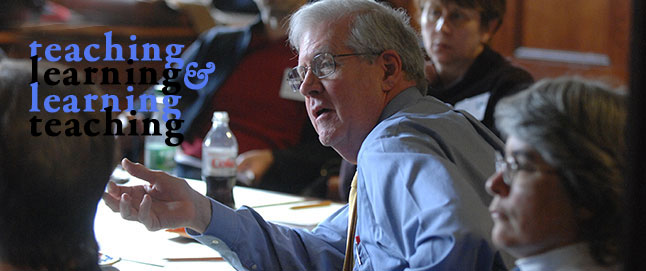
features |
1 > |

A center where faculty members learn from each other by sharing their classroom experience
Faculty members teach students, but who teaches teachers how to teach? How do young faculty members learn classroom skills? How do veteran teachers stay fresh and vital? Trinity’s new Center for Teaching and Learning is dedicated to finding out and to making a great faculty even better.
This fall marks the beginning of the second year for Trinity’s Center for Teaching and Learning, and the co-directors—Associate Professor of Psychology Dina Anselmi and Professor of History Gary Reger—couldn’t be happier.
“In the first year we held eight new-faculty seminars and five round table discussions,” explains Reger as he ticks off a list of the center’s events. “Two of the round tables—quantitative literacy and arts literacy—were so popular that we had to schedule follow-up discussions. I think that’s great news!”
In its first year of operation, the center set out to accomplish four goals:
- Become the entity out of which the new faculty orientation would run.
- Serve the faculty at large.
- Develop a model plan for mentoring new faculty.
- Align the center with the other campus centers such as the Alan K. Smith Center for Writing and Rhetoric and the Aetna Quantitative Center.
“We didn’t want to start off doing a hundred things,” says Anselmi. “But just when we thought there wasn’t room to do anything else, we would see something really great and say ‘we have to do this!’”
A place for everyone to think more deliberately about what it means to teach
The idea for the center began in the fall of 2007, when Dean of Faculty Rena Fraden convened a faculty advisory committee to discuss the College’s teaching mission. The committee proposed a center for teaching and learning and began the work of putting together the center’s structure, including appointing two of their colleagues as co-directors. In October 2008, the center was awarded a four-year, $365,000 grant from the Andrew W. Mellon Foundation, and the College committed to raising an endowment to support the center’s work.
“I saw two important goals for this center,” says Dean Fraden. “That it provide a framework and space for junior faculty members to identify similar experiences, and that it be a place for everyone to think more deliberately about what it means to teach.”
In formulating the structure of the center, Reger and Anselmi did not want simply to create another administrative office, which is the model of teaching and learning centers often found at larger research institutions. Their goal was to create an environment where Trinity’s faculty members could learn from each other through conversations and by sharing their classroom experiences.
“The center will be most successful if it reflects the diversity of the faculty’s interests,” says Anselmi. “What’s most exciting to me is when ideas for seminars or discussions come from other faculty members.”
Reger echoes the sentiment: “The center is for faculty, by faculty.”
|
|
1 > |
